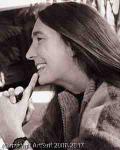Jenny Holzer
Jenny Holzer
Místo: Gallipolis
Narozený: 1950
Životopis:
Jenny Holzer is an American neo-conceptual artist, based in Hoosick Falls, New York. The main focus of her work is the delivery of words and ideas in public spaces .
Holzer belongs to the feminist branch of a generation of artists that emerged around 1980, looking for new ways to make narrative or commentary an implicit part of visual objects. Her contemporaries include Barbara Kruger, Cindy Sherman, Sarah Charlesworth, and Louise Lawler.
The public dimension is integral to Holzer's work. Her large-scale installations have included advertising billboards, projections on buildings and other architectural structures, and illuminated electronic displays. LED signs have become her most visible medium, although her diverse practice incorporates a wide array of media including street posters, painted signs, stone benches, paintings, photographs, sound, video, projections, the Internet, and a race car for BMW. Text-based light projections have been central to Holzer’s practice since 1996. As of 2010, her LED signs have become more sculptural. Holzer is no longer the author of her texts, and in the ensuing years, she returned to her roots by painting.
Originally aspiring to become an abstract painter, Holzer's studies included general art courses at Duke University in Durham, North Carolina (1968–1970), and then painting, printmaking and drawing at the University of Chicago before completing her BFA at Ohio University, Athens (1972). In 1974, Holzer took summer courses at the Rhode Island School of Design, and entered its MFA program in 1975. She moved to Manhattan in 1976, joined the Whitney Museum's independent study program and began her first work with language, installation and public art. She also was an active member of the artists group Colab.
Holzer's initial public works, Truisms (1977–79), are among her best-known. They first appeared as anonymous broadsheets that she printed in black italic script on white paper and wheat-pasted to buildings, walls and fences in and around Manhattan. These one-liners are a distillation of an erudite reading list from the Whitney Independent Study Program, where she was a student. She printed other Truisms on posters, T-shirts and stickers, and carved them into stone benches. In late 1980, Holzer's mail art and street leaflets were included in the exhibition Social Strategies by Women Artists at London's Institute of Contemporary Arts, curated by Lucy Lippard.
In 1981, Holzer initiated the Living series, printed on aluminum and bronze plaques, the presentation format used by medical and government buildings. The Living series addressed the necessities of daily life: eating, breathing, sleeping, and human relationships. Her bland, short instructions were accompanied by paintings by American artist Peter Nadin, whose portraits of men and women attached to metal posts further articulated the emptiness of both life and message in the information age.
Inflammatory Essays was a work consisting of posters Holzer created from 1979 to 1982 and put up throughout New York. The statements on the posters were influenced by political figures including Emma Goldman, Vladimir Lenin, and Mao Tse-Tung. In 2018 an excerpt from that work was printed on a card stitched onto the back of the dress Lorde wore to the Grammys; the excerpt read, "Rejoice! Our times are intolerable. Take courage, for the worst is a harbinger of the best. Only dire circumstance can precipitate the overthrow of oppressors. The old & corrupt must be laid to waste before the just can triumph. Contradiction will be heightened. The reckoning will be hastened by the staging of seed disturbances. The apocalypse will blossom." Others at the Grammys wore white roses or all-white clothes to express solidarity with the Time's Up movement; Lorde wrote, "My version of a white rose — THE APOCALYPSE WILL BLOSSOM — an excerpt from the greatest of all time, jenny holzer."
The medium of modern computer systems became an important component in Holzer's work in 1982, when the artist installed her first large electronic sign on the Spectacolor board in New York's Times Square. Sponsored by the Public Art Fund program, the use of light-emitting diodes (LEDs) allowed Holzer to reach a larger audience. The texts in her subsequent Survival series, compiled in 1983-85, speak to the great pain, delight, and ridiculousness of living in contemporary society. She began working with stone in 1986; for her exhibition that year at the Barbara Gladstone Gallery in New York, Holzer introduced a total environment where viewers were confronted with the relentless visual buzz of a horizontal LED sign and stone benches leading up to an electronic altar. Continuing this practice, her installation at the Guggenheim Museum in 1989 featured a 163-meter-long sign forming a continuous circle spiraling up a parapet wall.
In 1989, Holzer became the second female artist chosen to represent the United States at the Venice Biennale in Italy (Diane Arbus work was the first, shown posthumously, in 1972). At the 44th Biennale in 1990, her LED signboards and marble benches occupied a solemn and austere exhibition space in the American Pavilion; she also designed posters, hats, and T-shirts to be sold in the streets of Venice. The installation, Mother and Child, won Holzer the Leone D'Oro for best pavilion. The original installation is retained in its entirety in the collection of the Albright-Knox Art Gallery in Buffalo, the organizing institution for the American Pavilion at the 1990 Biennale.
More...
Wikipedia link: Click Here














